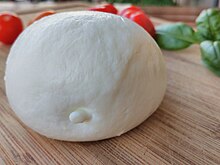Pasta filata (lit. 'spun paste') is a technique in the manufacture of a family of Italian cheeses also known in English as stretched-curd, pulled-curd, and plastic-curd cheeses.[1] Stretched curd cheeses manufactured using the pasta filata technique undergo a plasticising and kneading treatment of the fresh curd in hot water, which gives the cheese its fibrous structure.[2]

The cheese-making begins in the normal way. The milk (usually from cows or water buffalo) is warmed and curdled and allowed to rest for an hour before the curds are cut into small pieces and the whey is drained off. The curds are allowed to rest for a number of hours.[3] Then follows the filatura, which is when the curds are steeped for some hours in a bath of very hot whey, or water (for mozzarella di bufala campana the temperature is 95 °C). Once they begin to float, most of the liquid is removed and the curd is mixed and kneaded until the required soft, elastic, stringy texture is obtained. The mass of curd is divided (often by pulling out a thick strand and chopping it) and shaped into individual cheeses. In the case of mozzarella, the process is now essentially complete—ideally these cheeses should be eaten within a few days.
For other formaggi a pasta filata, such as provolone, caciocavallo silano, pallone di Gravina, burrata, and scamorza, further processing is needed: ageing and, in some cases, brining or smoking.
Chemistry
editPhosphate groups attached to the casein proteins in the cheese curd are highly charged but repel each other. Naturally high levels of calcium ions are found in the casein micelles of the cheese curd and allow the casein micelles to form a more rigid network by bridging the steric hindrance created by the self-repelling phosphate groups. Calcium ions are removed during the production of pasta filata cheeses.[4] This increases the repulsion casein micelles have against each other, allowing the micelle to become less dense and more extensible.
A relatively high amount of calcium is removed during the cheese making process, reducing the overall amount of this nutrient in mozzarella relative to other cheeses. Relative to cheddar cheese, mozzarella has 40% less calcium.[5][6]
See also
edit- List of Italian cheeses
- List of stretch-curd cheeses – cheeses prepared using the pasta filata technique
- Types of cheese – classification of coagulated milk products
References
edit- ^ Patrick F. Fox; Paul L. H. McSweeney; Timothy M. Cogan & Timothy P. Guinee (2004). Cheese: Chemistry, Physics and Microbiology: Major Cheese Groups. Elsevier. pp. 251–277. ISBN 9780080500942. Retrieved 8 January 2018.
- ^ U.S. patent 7,955,814 citing Kindstedt, Paul S. (1999). "Mozzarella and Pizza Cheese". Cheese: Chemistry, Physics and Microbiology. Vol. 2: Major cheese groups (second ed.). Elsevier Science & Technology. pp. 337–341. doi:10.1007/978-1-4615-2800-5_12. ISBN 0834213389. OCLC 634036414.
- ^ "Provolone Piccante". www.cheesemonthclub.com. Retrieved 2018-10-24.
- ^ "Representation of the casein micelle dual binding model proposed by Horne".
- ^ "FoodData Central". fdc.nal.usda.gov. Retrieved 2023-05-31.
- ^ "FoodData Central". fdc.nal.usda.gov. Retrieved 2023-05-31.